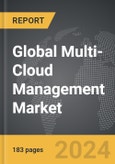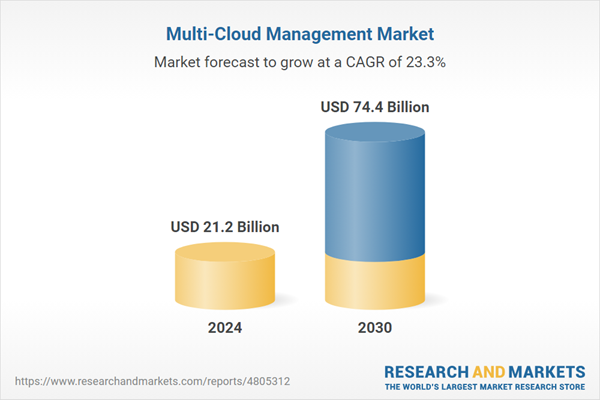The global market for Multi-Cloud Management was valued at US$21.2 Billion in 2024 and is projected to reach US$74.4 Billion by 2030, growing at a CAGR of 23.3% from 2024 to 2030. This comprehensive report provides an in-depth analysis of market trends, drivers, and forecasts, helping you make informed business decisions. The report includes the most recent global tariff developments and how they impact the Multi-Cloud Management market.
Segments: Solutions (Cloud Automation, Managed Services, Reporting & Analytics, Security & Risk Management, Training & Consulting, Other Solutions); Organization Size (Large Enterprises, SMEs); End-Use (BFSI, IT & Telecom, Media & Entertainment, Consumer Goods & Retail, Manufacturing, Government, Healthcare, Other End-Uses).
Geographic Regions/Countries: World; United States; Canada; Japan; China; Europe (France; Germany; Italy; United Kingdom; and Rest of Europe); Asia-Pacific; Rest of World.
The analysts continuously track trade developments worldwide, drawing insights from leading global economists and over 200 industry and policy institutions, including think tanks, trade organizations, and national economic advisory bodies. This intelligence is integrated into forecasting models to provide timely, data-driven analysis of emerging risks and opportunities.
Global Multi-Cloud Management Market - Key Trends & Drivers Summarized
What Is Multi-Cloud Management and Why Is It Essential?
Multi-cloud management refers to the process of overseeing and optimizing the use of multiple cloud computing services across different cloud environments. Businesses increasingly adopt a multi-cloud strategy to avoid reliance on a single cloud service provider (CSP), improve data redundancy, enhance flexibility, and ensure optimal resource allocation. Through multi-cloud management, organizations can effectively monitor, manage, and control the workloads, security, compliance, and costs associated with their cloud infrastructure. This management approach provides the ability to seamlessly switch between public, private, and hybrid clouds, offering businesses greater agility and resilience. In an era where cloud computing dominates the IT landscape, multi-cloud management has become critical for enterprises looking to leverage the strengths of various cloud platforms while mitigating risks related to vendor lock-in, system failures, or regulatory issues.How Are Technological Innovations Shaping Multi-Cloud Management?
Technological advancements in automation, artificial intelligence (AI), and orchestration tools are revolutionizing the multi-cloud management landscape. AI-driven solutions enable businesses to automate cloud resource allocation, monitor performance metrics, and optimize workloads across multiple platforms in real-time. These systems can automatically adjust resources depending on current needs, enhancing efficiency and minimizing costs. Furthermore, innovations in cloud orchestration platforms are allowing organizations to automate the deployment and scaling of applications across different cloud environments. These platforms streamline workflows, simplify application migration between clouds, and ensure seamless integration of different cloud services. Additionally, the rise of Kubernetes and containerization technology has accelerated the adoption of multi-cloud strategies by simplifying the management of applications across distributed cloud infrastructure. Such developments are making multi-cloud management more accessible and efficient, empowering organizations to deploy sophisticated cloud strategies without extensive manual intervention.Why Is Multi-Cloud Management Crucial for Business Resilience and Flexibility?
As businesses increasingly adopt digital transformation strategies, ensuring resilience and flexibility in cloud operations has become paramount. Multi-cloud management provides a critical layer of control that allows enterprises to diversify their infrastructure, reducing the risk of downtime or performance issues tied to a single provider. This approach is particularly valuable in industries that require high availability, such as finance, healthcare, and e-commerce, where any downtime could have significant operational and financial consequences. Moreover, multi-cloud management allows organizations to take advantage of competitive pricing models, selecting the best service for specific tasks, whether it's computing power, storage, or data processing. The ability to distribute workloads across multiple cloud environments also supports disaster recovery and business continuity strategies, allowing businesses to shift operations quickly in the event of outages or disruptions. As data privacy regulations evolve, multi-cloud management is helping businesses maintain compliance by ensuring that sensitive data can be stored in specific geographic locations or under particular legal frameworks.What Are the Key Growth Drivers in the Multi-Cloud Management Market?
The growth in the multi-cloud management market is driven by several factors related to technological advancements, enterprise needs, and evolving industry practices. First, the increasing adoption of hybrid and multi-cloud strategies by enterprises is a major driver, as businesses seek to optimize their IT infrastructure by leveraging the strengths of various cloud service providers. Furthermore, the rising complexity of IT environments, combined with the need for enhanced security, cost optimization, and performance monitoring, is pushing companies to adopt sophisticated multi-cloud management platforms. The surge in demand for AI-driven automation tools is also propelling growth, as businesses look for ways to reduce the complexity of managing multiple clouds. Additionally, regulatory compliance requirements, particularly in sectors like finance, healthcare, and government, are driving the need for robust multi-cloud management solutions to ensure data security and compliance. Finally, the increased reliance on digital services in the post-pandemic era has heightened the need for scalable, resilient cloud infrastructure, further contributing to the market’s expansion.Report Scope
The report analyzes the Multi-Cloud Management market, presented in terms of units. The analysis covers the key segments and geographic regions outlined below.Segments: Solutions (Cloud Automation, Managed Services, Reporting & Analytics, Security & Risk Management, Training & Consulting, Other Solutions); Organization Size (Large Enterprises, SMEs); End-Use (BFSI, IT & Telecom, Media & Entertainment, Consumer Goods & Retail, Manufacturing, Government, Healthcare, Other End-Uses).
Geographic Regions/Countries: World; United States; Canada; Japan; China; Europe (France; Germany; Italy; United Kingdom; and Rest of Europe); Asia-Pacific; Rest of World.
Key Insights:
- Market Growth: Understand the significant growth trajectory of the Cloud Automation segment, which is expected to reach US$28.3 Billion by 2030 with a CAGR of a 25.9%. The Managed Services segment is also set to grow at 22.4% CAGR over the analysis period.
- Regional Analysis: Gain insights into the U.S. market, valued at $6.2 Billion in 2024, and China, forecasted to grow at an impressive 22.4% CAGR to reach $11.2 Billion by 2030. Discover growth trends in other key regions, including Japan, Canada, Germany, and the Asia-Pacific.
Why You Should Buy This Report:
- Detailed Market Analysis: Access a thorough analysis of the Global Multi-Cloud Management Market, covering all major geographic regions and market segments.
- Competitive Insights: Get an overview of the competitive landscape, including the market presence of major players across different geographies.
- Future Trends and Drivers: Understand the key trends and drivers shaping the future of the Global Multi-Cloud Management Market.
- Actionable Insights: Benefit from actionable insights that can help you identify new revenue opportunities and make strategic business decisions.
Key Questions Answered:
- How is the Global Multi-Cloud Management Market expected to evolve by 2030?
- What are the main drivers and restraints affecting the market?
- Which market segments will grow the most over the forecast period?
- How will market shares for different regions and segments change by 2030?
- Who are the leading players in the market, and what are their prospects?
Report Features:
- Comprehensive Market Data: Independent analysis of annual sales and market forecasts in US$ Million from 2024 to 2030.
- In-Depth Regional Analysis: Detailed insights into key markets, including the U.S., China, Japan, Canada, Europe, Asia-Pacific, Latin America, Middle East, and Africa.
- Company Profiles: Coverage of players such as Accenture PLC, BMC Software, Inc., CenturyLink, Inc., Citrix Systems, Inc., Cloudmore AB and more.
- Complimentary Updates: Receive free report updates for one year to keep you informed of the latest market developments.
Some of the 24 companies featured in this Multi-Cloud Management market report include:
- Accenture PLC
- BMC Software, Inc.
- CenturyLink, Inc.
- Citrix Systems, Inc.
- Cloudmore AB
- Cloudyn
- Dell Technologies
- Doublehorn
- IBM Corporation
- Jamcracker, Inc.
- RightScale, Inc.
- SixSq Sarl
- Turbonomic, Inc.
- VMware, Inc.
Tariff Impact Analysis: Key Insights for 2025
Global tariff negotiations across 180+ countries are reshaping supply chains, costs, and competitiveness. This report reflects the latest developments as of April 2025 and incorporates forward-looking insights into the market outlook.The analysts continuously track trade developments worldwide, drawing insights from leading global economists and over 200 industry and policy institutions, including think tanks, trade organizations, and national economic advisory bodies. This intelligence is integrated into forecasting models to provide timely, data-driven analysis of emerging risks and opportunities.
What’s Included in This Edition:
- Tariff-adjusted market forecasts by region and segment
- Analysis of cost and supply chain implications by sourcing and trade exposure
- Strategic insights into geographic shifts
Buyers receive a free July 2025 update with:
- Finalized tariff impacts and new trade agreement effects
- Updated projections reflecting global sourcing and cost shifts
- Expanded country-specific coverage across the industry
Table of Contents
I. METHODOLOGYII. EXECUTIVE SUMMARY2. FOCUS ON SELECT PLAYERSIII. MARKET ANALYSISIV. COMPETITION
1. MARKET OVERVIEW
3. MARKET TRENDS & DRIVERS
4. GLOBAL MARKET PERSPECTIVE
UNITED STATES
CANADA
JAPAN
CHINA
EUROPE
FRANCE
GERMANY
ITALY
UNITED KINGDOM
REST OF EUROPE
ASIA-PACIFIC
REST OF WORLD
Companies Mentioned (Partial List)
A selection of companies mentioned in this report includes, but is not limited to:
- Accenture PLC
- BMC Software, Inc.
- CenturyLink, Inc.
- Citrix Systems, Inc.
- Cloudmore AB
- Cloudyn
- Dell Technologies
- Doublehorn
- IBM Corporation
- Jamcracker, Inc.
- RightScale, Inc.
- SixSq Sarl
- Turbonomic, Inc.
- VMware, Inc.
Table Information
| Report Attribute | Details |
|---|---|
| No. of Pages | 183 |
| Published | April 2025 |
| Forecast Period | 2024 - 2030 |
| Estimated Market Value ( USD | $ 21.2 Billion |
| Forecasted Market Value ( USD | $ 74.4 Billion |
| Compound Annual Growth Rate | 23.3% |
| Regions Covered | Global |









